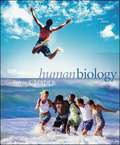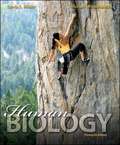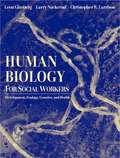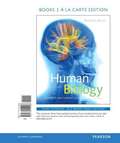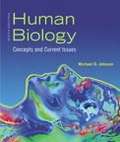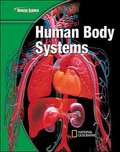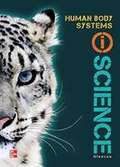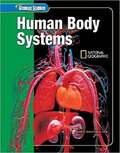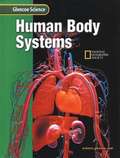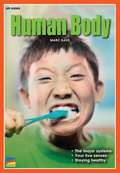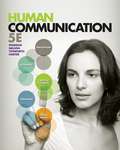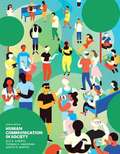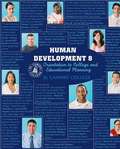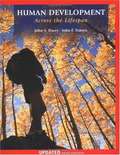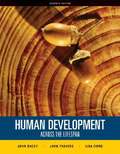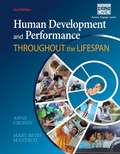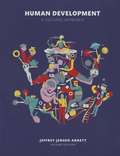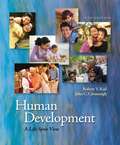- Table View
- List View
Human Biology (9th Edition)
by Sylvia S. MaderIn this edition, as in previous editions, each chapter presents the topic clearly and distinctly so that students will feel capable of achieving an adult level of understanding. Detailed, high-level scientific data and terminology are not included because Dr. Mader believes that true knowledge consists of working concepts rather than technical facility.
Human Biology (Thirteenth Edition)
by Sylvia S. Mader Michael WindelspechtInstructors consistently ask for a human biology textbook that helps students develop an understanding of the main themes of biology while placing the material in the context of the human body. Mader's Human Biology was developed to fill this void. To accomplish the goal of improving scientific literacy, while establishing a foundation of knowledge in human biology and physiology, Human Biology integrates a tested, traditional learning system with modern digital and pedagogical approaches designed to stimulate and engage today's student. Multimedia Integration: Michael Windelspecht represents the new generation of digital authors. Through the integration of multimedia resources, such as videos, animations and MP3 files, and in the design of a new series of guided tutorials, Dr Windelspecht has worked to bring Dr. Mader's texts to the new generation of digital learners. A veteran of the online, hybrid, and traditional teaching environments, Dr. Windelspecht is well versed in the challenges facing today's students and educators. Dr. Windelspecht guided all aspects of the Connect content accompanying Human Biology. The authors of the text identified several goals that guided them through the revision of Human Biology, Thirteenth Edition: build upon the strengths of the previous editions of the text, enhance the learning process by integrating content that appeals to today's students, deploy new pedagogical elements, including multimedia assets, to increase student interaction with the text, develop a new series of digital assets designed to engage the modern student and provide assessment of learning outcomes.
Human Biology for Social Workers: Development, Ecology, Genetics, and Health
by Leon Ginsberg Larry Nackerud Christopher LarrisonThis engaging and accessible supplemental text will give students a basic understanding of human biology and how it relates to human behavior and the social environment. It successfully integrates social work theory with human biology theory.
Human Biology: Concepts And Current Issues (Eighth Edition)
by Michael D. JohnsonThrough his teaching, his textbook, and in his online blog, award-winning teacher Michael D. Johnson sparks the interest of today’s science-intimidated student by connecting basic biology to real-world issues relevant to students' own lives. Through a storytelling approach and extensive online support, Human Biology: Concepts and Current Issues not only demystifies how the human body works but drives students to become better consumers of health and science information. Each chapter opens with Johnson’s popular "Current Issue" essays, and BlogInFocus references within the chapter direct students to his frequently-updated online blog for breaking human biology-related news.
Human Biology: Concepts and Current Issues (6th edition)
by Michael D. JohnsonAward-winning teacher Michael D. Johnson catches your interest immediately by connecting basic biology concepts to real-world issues that are relevant to your life. Through a storytelling approach and extensive online support, Human Biology: Concepts and Current Issues, 6th Edition not only demystifies how the human body works but helps you to become a better consumer of health and science information. Each chapter now opens with Johnson's popular "Current Issue" essays, and inside each chapter are entries from the author's own, frequently updated blog. Expanded online resources are now available and conveniently referenced in chapter sections with icons and URLs. The 6th Edition also offers you stronger self-assessment tools, with new and expanded critical-thinking questions throughout each chapter and in the end-of-chapter reviews.
Human Body Systems
by Glencoe Mcgraw-HillDiscover the Flexibility to Teach Science Your Way!. "Glencoe Science: Human Body Systems," a module in the Glencoe Science 15 book series, provides students with accurate and comprehensive coverage of middle school National Science Education Standards. Concepts are explained in a clear, concise manner, and are integrated with a wide range of hands-on experiences, critical thinking opportunities, real-world applications, and connections to other sciences and to non-science areas of the curriculum. Co-authored by National Geographic, unparalleled graphics reinforce key concepts. A broad array of print and technology resources help differentiate and accommodate all learners. The modular approach allows you to mix and match books to meet your specific curriculum needs.
Human Body Systems IScience
by Glencoe Mcgraw-Hill American Museum of Natural HistoryMiddle School Science
Human Body Systems: Book D (Glencoe Science)
by McGraw-Hill EducationHuman Body Systems, as a part of the Glencoe Science 15-Book Series, provides students with accurate and comprehensive coverage of the human body and its key organ systems. The strong content coverage integrates a wide range of hands-on experiences, critical-thinking opportunities, and real-world applications. The modular approach allows you to mix and match books to meet your curricula.
Human Body Systems: Course D
by McGraw-Hill Glencoe"Science meets students where they are through engaging features and thought-provoking questions that encourage them to relate the science concepts to the world around them.
Human Body: FOSS Science Stories
by University of California at Berkeley Lawrence Hall of ScienceNIMAC-sourced textbook
Human Communication Fifth Edition
by Scott Titsworth Lynn Harter Paul Nelson Judy PearsonHuman Communication is an integrated program that helps students practice communication skills, build confidence in public speaking, and achieve success in their introductory communication course. With McGraw-Hill LearnSmart in Connect Communication, students separate what they know from what they think they know, following a continually adaptive learning path toward mastery of key concepts. Additionally, Connect provides students with the resources they need to construct well-planned speeches while its highly flexible speech capture tool saves instructors valuable time in managing assignments and evaluating student speeches. Rooted in current scholarship and with an eye on practical, everyday communication scenarios, Human Communication is designed to make introductory communication studies immediate and relevant to students. Following their writing mantra, “Make it Smart. Keep it Real,” the authors strike a balance of definitive theory and everyday application that resonates with the challenges and goals of today's typical basic course.
Human Communication In Society
by Judith N. Martin Thomas K. Nakayama Jess K. AlbertsHuman Communication in Society takes an enhanced look at the relationship between humans and their societies through a contemporary critical lens. By examining history and societal structures as a means to assess modes of human communication, the text helps readers to understand the theory and context of the way people interact. <p><p> The Fourth Edition uses new examples, illustrations, and pedagogical materials to highlight the importance of understanding multiple perceptions when studying communication. By addressing vital forms of communication such as listening, responding, verbal/non-verbal communication, and perception, Human Communication in Society addresses the subject of interpersonal interaction from a holistic standpoint.
Human Development 8: Orientation to College and Educational Planning
by Skip DowningHuman Development 8 is a brief orientation book to El Camino College. This text book aids and guides students in the development of skills and fulfillment of personal goals as well as their dreams
Human Development Across The Lifespan
by John S. Dacey John F. TraversThis chronologically-organized text is briefer than most of the Human Lifespan texts. Its numerous examples drawn from education, nursing, and psychology make the content relevant to students from a variety of majors and backgrounds, while a highly praised study guide integrated into the text promotes and reinforces conceptual understanding. The new edition includes increased material on cognitive development and expanded coverage of culture. .
Human Development Across the Lifespan
by Lisa B. Fiore John S. Dacey John F. TraversAll of the lifespan without all of the bells and whistles. This chronologically-organized text is less expensive and briefer than most Lifespan texts. Its numerous examples drawn from education, nursing, and psychology make the content relevant to students from a variety of majors and backgrounds, while a highly praised study guide integrated into the text promotes and reinforces conceptual understanding.
Human Development and Performance Throughout the Lifespan
by Anne Cronin Mary Beth MandichHuman Development & Performance Throughout the Lifespan, 2nd Edition is ideal for occupational therapy, physical therapy, and other rehabilitation disciplines. It provides a broad, occupation-based viewpoint of development and performance throughout all life stages with an emphasis on the factors that influence daily participation and optimal performance of desired daily life tasks. The authors use a life course conceptual model as an organizational foundation for clinical reasoning to help readers understand how to implement the activity- and participation-based goals and outcomes for therapy. Written by an occupational therapist and a physical therapist, the book incorporates chapters by leading experts in human development, giving users cutting-edge information and a wide range of perspectives. By integrating information from the International Classification of Function and Disability (ICF) with a developmental life-task perspective, the book gives both newcomers and experienced professionals an essential, contemporary frame of reference.
Human Development: A Cultural Approach
by Jeffrey ArnettHelp students understand how culture impacts development – and why it matters Human Development: A Cultural Approach, Second Edition leads students to examine all stages of development through the engaging lens of culture. The first author to take a wholly cultural approach to human development, Jeffrey Arnett integrates cross-cultural examples throughout the narrative to reveal the impact of cultural factors both in the US and around the world. Arnett’s emphasis on culture fosters a thorough, balanced view of development that prepares students to face challenges in our diverse and globalized world – whether they travel the globe or remain in their hometowns.
Human Development: A Life-Span View
by John Cavanaugh Robert KailBalanced coverage of the entire life span is just one thing that distinguishes HUMAN DEVELOPMENT: A LIFE-SPAN VIEW, 6TH EDITION. With its comprehensive, succinct, and applied coverage, the text has proven its ability to capture students' interest while introducing them to the issues, forces, and outcomes that make us who we are. Robert V. Kail's expertise in childhood and adolescence, combined with John C. Cavanaugh's extensive research in gerontology, result in a book with a rich description of all life-span stages and important topics. A modified chronological approach traces development in sequential order from conception through late life, while also dedicating several chapters to key topical issues. This organization also allows the book to be relatively briefer than other texts a benefit given the enormous amount of information covered in the course.
